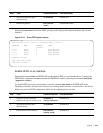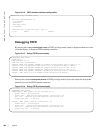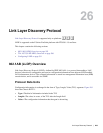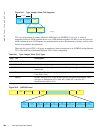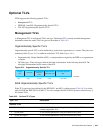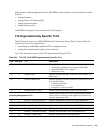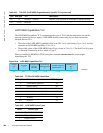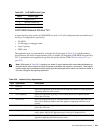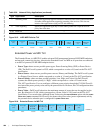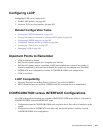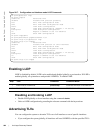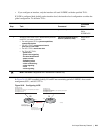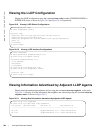
Link Layer Discovery Protocol | 587
With regard to connected endpoint devices, LLDP-MED provides network connectivity devices with the
ability to:
• manage inventory
• manage Power over Ethernet (PoE)
• identify physical location
• identify network policy
LLDP-MED is designed for, but not limited to, VoIP endpoints.
TIA Organizationally Specific TLVs
The Dell Force10 system is an LLDP-MED Network Connectivity Device (Device Type 4). Network
connectivity devices are responsible for:
• transmitting an LLDP-MED capabilities TLV to endpoint devices
• storing the information that endpoint devices advertise
Table describes the five types of TIA-1057 Organizationally Specific TLVs.
Table 26-3. TIA-1057 (LLDP-MED) Organizationally Specific TLVs
Type Sub-type TLV Description
127 1 LLDP-MED Capabilities Indicates:
• whether the transmitting device supports LLDP-MED
• what LLDP-MED TLVs it supports
• LLDP device class
127 2 Network Policy Indicates the application type, VLAN ID, Layer 2 Priority, and
DSCP value
127 3 Location Identification Indicates the physical location of the device expressed in one of
three possible formats:
• Coordinate Based LCI
• Civic Address LCI
• Emergency Call Services ELIN
127 4 Extended Power via MDI Indicates power requirements, priority, and power status
Inventory Management TLVs
Implementation of this set of TLVs is optional in LLDP-MED
devices. None or all TLVs must be supported. FTOS does not
currently support these TLVs.
127 5 Inventory - Hardware Revision Indicates the hardware revision of the LLDP-MED device
127 6 Inventory - Firmware Revision Indicates the firmware revision of the LLDP-MED device
127 7 Inventory - Software Revision Indicates the software revision of the LLDP-MED device
127 8 Inventory - Serial Number Indicates the device serial number of the LLDP-MED device
127 9 Inventory - Manufacturer Name Indicates the manufacturer of the LLDP-MED device
127 10 Inventory - Model Name Indicates the model of the LLDP-MED device



